So you’re a new owner of this cool glass carafe? If you’re a bit confused looking at all the different types of Chemex filters and their alternatives I totally understand.
When deciding which filter will suit your taste and requirements best, you need to take into consideration a couple of factors.
Are you looking to have coffee with the perfect taste and what does that actually mean, based on your personal preference?
Or, perhaps, you’re searching for a permanent filter solution that’s reusable?
Is there a difference between the coffee, produced with the white and brown paper versions? Should you go for a metal one and would you even be able to tell the difference between each alternative when it comes to flavor?
Could you use regular cheaper filters with the Chemex brewing vessel? Why are the originals so special? Where can you buy these at the most favorable price?
Doesn’t matter whether you’re driven by the price, taste, quality, durability, or the most eco-friendly option – in this article I tried to include all the information you need when deciding which filter is the best for your Chemex carafe.
So let’s dive in.
For those of you who are in a hurry, you can check out the table below, where I’ve listed all of the filters that I’ve reviewed:
| Brand: | Type: | Compatibility: |
|---|---|---|
| 1. Chemex | paper | all Chemex series |
| 2. Able Kone | stainless steel | 6, 8, 10-cup |
| 3. CoffeeSock | organic cotton | all Chemex series |
| 4. Barista Warrior | stainless steel | 6, 8, 10-cup |
| 5. Hemp by Bolio | organic hemp | 6, 8, 10-cup |
| 6. Apace Living | stainless steel | 6, 8, 10-cup |
A Guide on Chemex Filters
Figuring out which is the product that will suit your taste and needs isn’t hard.
I understand that at first, you may feel a bit confused facing all the options out there, but reading the main clarifications below will definitely help you out.
So here is a complete guide on Chemex filter papers and their alternatives:
1. Brown Versus White
Here is the difference between brown and white Chemex filters:
White Chemex filters are bleached through an oxidizing cleansing bath, followed by a series of hot water baths.
The brown versions don’t go through the oxidizing process, which is why they have a natural brown color.
When it comes to how much the filter affects coffee taste, the disadvantage of using natural filters is that they are more likely to result in a slightly more papery-flavored coffee.
This is why you need to make sure you’ve rinsed the unbleached filter with hot water well enough before use to avoid this undesired result.
White coffee filters also need some hot water to go through them before you add the coffee grounds.
This rinsing procedure is necessary to remove dust and paper fibers if present.
Furthermore, if you pre-wet your paper with hot water, the first extracted bits of coffee won’t be soaking in it.
This procedure will also even out the temperature and will overall result in a better coffee flavor.
Natural paper filters are usually preferred by people who don’t feel comfortable using bleached versions.
Most of us who prefer brown papers are driven by either environmental concerns or the health issues bleached papers have been associated with.
“…the whitening process these filters undergo is a food-grade hydrogen peroxide oxygen cleansing process. Chemex knows that bleach or chlorine would change the outcome of the coffee and we do not use these substances for whitening…
…Our manufacturing department has provided further feedback and for these white filters, Chemex uses an elemental chlorine-free (ECF) pulping process to produce sulphite pulp for paper manufacturing operations. As a result, no elemental chlorine is used in the bleaching process.”
Chemex Customer Service Team
ECF bleaching massively reduces the potential formation of dioxins as a result of the process, and minimizes chlorinated toxic pollutants.
When it comes to taste I have tested coffee, prepared with both filters side by side, and I wouldn’t say there is a huge difference.
But if you want to be sure that your coffee flavor won’t have a slight woody tint to it – stick to the white filter.
I personally go for the natural version and am pretty happy with my choice.
2. Square Versus Round
When it comes to shape, here is what you may need to know:
There’s no difference between the quality of the square and the round Chemex filters.
They are made from the same material and you won’t be able to feel any inequalities in the taste of the coffee they produce.
Choosing one or the other is a matter of your personal aesthetic preferences.
When it comes to their practical differences in everyday use, some people find it a bit easier to take out a square filter, as its edges stick up, making it easier to hold onto.
It has never been a problem for me to remove the round ones too, so I wouldn’t say this is a significant advantage of the square ones.
I personally prefer the square filters, as think they look cooler.
I feel they totally resonate with the overall look and feel of the timeless and stylish design of the Chemex carafe, which I love.
3. Do You Have Other Options?
If you are wondering whether there are any alternatives to Chemex filters:
There are a number of alternative filter options that you can use with a Chemex, but it’s the original double-bonded filter that will yield the distinguished coffee flavor and mouthfeel Chemex is known for.
Still, if you’re not keen on having that classic Chemex-style brew, you can invest in a reusable permanent filter version such as a stainless steel cone or a cloth filter.
I have reviewed the best Chemex alternatives to save you some time.
But before that, I think it would be useful to give you a general idea of the coffee you’ll get with each version:
- Chemex filters – you will get a lighter-bodied, clean cup with well-pronounced notes. No coffee sediment will be left at the bottom of your cup. Smooth, low acid coffee.
- Stainless steel reusable – fuller-bodied, closer to French press brew, but there’s not as much coffee residue, compared to when using a French press. You will likely find leftover sediment at the bottom of your carafe.
Related Post: Best French Press Coffee Makers - Cloth filter – fuller-bodied compared to Chemex, but lighter compared to the steel version. Most cloth filters trap all of the coffee grounds and let more of the coffee oils pass through it. It’s perfect for those who want fuller body, more complex flavor, creamy texture, but no sediment.
4.Could You Possibly Use Other Papers?
If you’re wondering whether you could use other paper filter brands with your Chemex carafe, I totally understand why you may be interested in doing so.
The original thick filters are a bit more expensive.
Also, depending on your location, the availability of the originals varies.
If you’re not a fan of online shopping, you may find yourself tempted to buy some substitute filters that are available at your grocery store.
But would it be worth it?
Generally, I wouldn’t recommend using paper filters other than the originals with a Chemex brewer.
Other brands produce thinner filters, which don’t filter as much of the oils, resulting in a slightly fuller-bodied cup.
That isn’t really the issue as some people prefer this type of brew.
Also, since they are designed to be used with different brewing equipment, other filters often collapse into your carafe while you pour in the water, because of the larger size of the Chemex neck.
They also stick to the Chemex edges and to the built-in spout, restricting air displacement.
This is why I wouldn’t include any of the paper substitutes on my list.
Still, some creative individuals have managed to figure out a way to make other filters work.
If you’re eager to become one of them, I would recommend starting out with the Hario v60 03 filters.
They work well with the Chemex 6-cup brewer, which is the most widely spread model.
For a closer to a Chemex-style filtration, you can double them up.
Just don’t overload them with grounds and use a chopstick to make sure that the filter doesn’t stick firmly to the walls and block the steam from escaping the brew chamber.
What Are the Best Chemex Filters and Their Alternatives?
Now that we’ve cleared up some essential details, I’m ready to list the best Chemex filters and their respective alternatives.
I made sure that I’ve only included products that are worth mentioning and are easily usable with the glass carafe.
So here are the best filters that you can use with a Chemex:
1. The Original Filters by Chemex – A lighter-bodied cup with a smooth flavor
Click here to see the current price and more photos on Amazon.
Of course, before reviewing the Chemex filter alternatives I should start out with the ones that are originally designed to be used with the vessel.
Тhey, along with said glass vessel, were invented by a chemist Dr. Peter Schlumbohm in 1941.
His knowledge in chemistry was useful when he invented these double-bonded filters.
They are the reason why, by using the Chemex, you get to have this crisp cup with a smooth yet complex flavor.
Nowadays, I feel like most people are more attracted by the fancy-looking carafe, but it’s actually the filters that will take your coffee experience to the next level.
The thick Chemex filters not only trap all small coffee particles from entering the decanter, but also filter coffee oils. This results in a lighter-bodied, but lovely and flavorful low-acid cup.
Some of the oily substances that can’t penetrate through the Chemex paper filters are diterpenes.
Their consumption is related to cholesterol increase, so that is another advantage to the Chemex filters.
I personally love the smoothly flavored ultra-clean cup I get to have with those papers.
A Chemex paper weighs just under 4.5 grams. Comparatively, AeroPress filters weigh around 0.17 grams, and a Hario V60 02 filter – around 1.4 grams.
So you get the idea – the originals are definitely thick.
Related Post: Best AeroPress Filters & Alternatives – Reviewed
The original Chemex filters are easy to use.
As I mentioned earlier, you will have to rinse with the hot water the brown filters a bit more thoroughly to avoid the paper flavors.
I personally prefer them, as I always go for a natural version, no matter the product I buy.
Note that the originals were not manufactured to be reused, but with a little effort on your part, this can be done.
I discuss this further a bit later in this article.
Anyway, It’s important to mention that if you have bought the Chemex carafe just because its looks cool, and you actually prefer a fuller-bodied cup, you may find that the other options in the list suit you better.
Leaving that aside, I would definitely recommend getting those thick Chemex filters, as there are no others that will give you this type of result.
Here are all of the Chemex filters you can choose from:
For 3 cup, unfolded:
As you can see, you will have to figure out how to fold if you have a 3 cup.
But it’s quite easy, so you’ll definitely learn fast.
Here is a pic that will help you out:
*Make sure you place the 3-sheet side facing your carafe spout. This ensures proper air flow during brewing.
Overall, the original filters by Chemex if you enjoy a lighter-bodied clean cup with less intensity, but still nuanced flavors.
2. Able Brewing Kone – Durable, reusable, for a fuller-bodied cup
Click here to see the current price and more photos on Amazon.
The Able Brewing Kone is one of the best Chemex filter alternatives – a permanent solution for those that are sick of restocking on the papers.
It’s made in the USA and it’s a bit more expensive than other options, but it’s definitely sturdy and will last for years.
It’s worth the investment.
It is a reusable stainless steel filter that is specially designed for the Chemex carafe.
The Able Kone walls don’t touch the glass, providing air circulation and proper coffee extraction.
This filter will let you have a fuller-bodied cup since more coffee oils can go through it during percolation.
If you enjoy a more intense coffee flavor than what the Chemex papers can give you, you can find the perfect solution in the Able Kone.
The coffee will be something between a Chemex and a French Press.
There will be some sediment left after brewing in your carafe, but I wouldn’t say that’s a deal-breaker for sure.
A friend of mine uses this cone and she’s had it for a couple of years now.
She says she just pours a bit more water and after brewing, she waits around a minute for all the sediment to gather at the bottom of her 6-cup.
After pouring the coffee, she leaves a tiny bit of it at the bottom where the residuals are, and throws the remainder away into the sink.
This way she makes sure no fines will find their way to her cup.
With that being said, when it comes to coffee sediment, there isn’t near as much as what’s left after using a French Press.

I have this reusable filter myself and I’m quite happy with how it works.
You can check it out in action in my Chemex brew guide.
The drawdown may take a bit longer with this filter if your grind is inconsistent, or in other words – with too many coffee fines.
These tiny coffee particles slow down draining, which may lead to over-extraction.
If that’s the case, you may want to consider getting a higher-quality burr grinder that provides consistent results on coarser settings.
You can check out my guide on the best grinders for pour-over to see reviews of my top manual and electric picks in this category.
There won’t be any metal flavor whatsoever after using the Able Kone, which isn’t the case with some cheaper reusable versions.
The plastic support ring that goes around the cone rim is made of food-grade plastic.
It’s worth noting that the plastic is never in contact with neither the hot water nor the coffee unless you purposely sip some on it.
Furthermore, it’s quite convenient to grab the ring when you swirl the hot coffee slurry during brewing, as it remains cold throughout the whole process.
Even though at first it seems too pricey, the Able Kone alternative to Chemex paper filters will serve you for years.
Furthermore, it won’t clog even if you’re a heavy coffee drinker and use it 2-3 times a day.
It is also easy to clean.
This way it will be much easier as grounds will still be wet and easily removable.
If you have a kitchen sink sprayer it will be even easier for you to clean the reusable cone.
Every once in a while you may want to dissolve a teaspoon of Urnex Cafiza in hot water and soak your metal Chemex filter in it.
This procedure will clean your permanent cone more thoroughly. You can also use an old toothbrush to wash it even better.
Actually, this cleaning process is beneficial for all metal filter alternatives that I review.
With all being said, this stainless steel cone filter is perfect for those of you who enjoy a fuller-bodied cup, want to reduce their waste, or want to stop buying expensive paper filters by investing in a high-quality reusable Chemex substitute.
3. CoffeeSock Organic Cotton – Eco-friendly substitute for creamy-textured coffee
Click here to see the current price and more photos on Amazon.
If you’re looking for an alternative to a Chemex filter, the cotton sock by CoffeeSock is my personal favorite.
But compared to the stainless steel cones – it’s lighter and the sediment is much less.
So, overall, – it’s the closest to a Chemex brew you’ll get.
Just a bit richer with a heavier mouthfeel and creamier texture.
That being said, it’s important to mention the fact that those filters are made in the USA with organic cotton.
If you’re looking for an eco-friendly sustainable substitute for your Chemex filters, those are the best solution for you.
By the way, the cotton CoffeeSock is also compostable.
When it comes to price this cotton filter cone is quite affordable. You get a pack of 2 filters.
Knowing how durable they are, with proper maintenance, even if you start using just one of them on a daily basis, after a year it would still perform well.
Yes, I said maintenance – you’ll have to put in a bit more work, compared to using the paper filters that you just throw away.
After each use, you should empty the sock, rinse it with water and leave it somewhere to dry.
It dries fast if the air humidity is low.
If you’re about to use it more than once a day, and for some reason, it hasn’t dried after the first use – well, you have a second sock.
Still, to stay on the safe side and avoid the accumulation of mildew, after each use you should rinse the filter well, and put it in a glass, or in a container, completely soaked in water.
Store the cloth filter in the fridge and when it’s time to prepare a cup – take it out and rinse it.
If you aren’t to use your coffee sock daily, after cleaning it, store it in a ziplock bag in the freezer.
When it’s time to use it again, just run it under hot water and it will be ready for a brew cycle.
If where you live the humidity is high and the sock can’t seem to dry out quickly, you should definitely use the aforementioned maintenance methods.
Furthermore, by putting a bit more effort into your sock’s cleaning and storing routine, you will extend its longevity.
Based on my personal experience, the cotton filters by the CoffeeSock dry out pretty fast and have never affected the coffee taste.
Furthermore, they affect coffee taste even less than the Chemex filters.
If you’re highly sensitive to the slight papery flavors that paper filters may contribute to, this filter is the perfect option for you.
It’s important to follow the instructions to boil the sock for 10 minutes before the first use.
After some time there would be some yellowish stains on the cotton filter, which won’t have any impact on your cup.
You can also dissolve a teaspoon of Cafiza by Urnex in hot water and soak the cotton sock in it.
This product will dissolve the coffee oil buildup and make your Chemex reusable cloth filter look as good as new.
Another piece of advice that you may find useful is to make sure that there is an air gap between the Chemex spout and the sock.
If the filter is totally blocking the air circulation things may get a bit messy.
Fixing a straw that bends between the spout and the sock works pretty well to avoid such an outcome.
I almost forgot to mention that while the steel reusable cones work only with the bigger Chemex brewers, these cotton filters have a version that perfectly fits the 3-cup brewer. You can check it out here.
Overall, the CoffeeSock is for those of you who are looking for a more sustainable, eco-friendly alternative to the Chemex filters but don’t want to give up on the clean cup that the originals make.
If you choose to get it, you will end up with a pour-over brew that’s pretty akin to the one, produced by the Hario Woodneck Drip Pot. If you want to learn more about the nel drip, check out this guide.
4. Barista Warrior Stainless Steel Filter – Budget-friendly multiple-use option
Click here to see the current price and more photos on Amazon.
Here is another option for those of you who don’t feel like restocking on the papers and aren’t a fan of the Chemex-style brew.
This Barista Warrior is cheaper than the Able Kone and has a different filter design.
It actually has two walls.
The internal one is a mesh and is also made of stainless steel.
Its goal is to keep all the grounds from entering your cup.
The downside to the double-wall mechanism is that it clogs up easier.
To avoid that, make sure you rinse the cone right after use.
And of course – the grind size – it’s recommended to use a medium to a coarse grind.
This way you’ll avoid clogging.
If you feel like the Barista Warrior drains much slower than usual – place it in the dishwasher and it will be ready to use again with the flow rate you’re used to.
While going through the dishwasher cycle the built-up coffee oils are removed by the hot water and the issue is resolved.
A mix of warm water and vinegar will also have a positive impact on the overall filter performance if you’ve been using it for a while.
When discussing the drawdown speed with the Barista Warrior, I have to mention that it’s faster compared to the drawdown with the paper filters and the Able Kone.
This means that if you are really, really into the art of coffee you will definitely notice that the extraction is not as you would expect.
As I already mentioned coarser grind is needed to prevent clogging.
But at the same time – not using a finer grind may lead to a fast drawdown and, ultimately, result in a slightly watery and under-extracted cup.
This can be prevented through the use of high-quality grinder that provides consistent results on coarse settings. Even if you grind more finely, as long as the coffee particles are even and there aren’t many fines – the coffee will draw down at an adequate pace.
That being said, I’m sure that some of you won’t even notice the slower drawdown. Furthermore, some not-so-passionate coffee consumers will actually enjoy the quicker flow rate in the early mornings.
You can decide for yourself whether you prefer more thorough rinsing (finer grind), investing in a high-quality grinder, or a slight under extraction (using a coarser grind).
With the Barista Warrior, you may find some sediment in your coffee, but as we already discussed, it’s not possible to achieve an ultra-clean cup with a filter other than the Chemex originals.
This stainless steel filter is also a bit more durable compared to the Ovalware one.
They are in the same price range (Ovalware is a bit less expensive), both manufactured in China, but I would choose the Barista Warrior, especially if I’m about to use my filter on a daily basis.
I think that this product is definitely worth the money and is one of the best reusable alternatives to the Chemex filters. Especially for those of you who aren’t rigorous about their coffee.
5. Bolio Hemp – Sustainable, affordable, and satisfying coffee flavor
Click here to see the current price and more photos on Amazon.
The hemp by Bolio is another one of the best eco-friendly reusable alternatives to the Chemex filters.
It would let a bit more sediment into your cup, compared to the Chemex filters, but not as much to affect your coffee experience negatively.
When it comes to upkeeping, the hemp filter requires the same maintenance routine, such as the one of the CoffeeSock.
Between uses you should either keep it submerged in water in the fridge, or in a ziploc bag in the freezer.
If you live in a place with low and stable air humidity, you can count on the air to extract the moisture out of your wet filter.
Nevertheless, to avoid unpleasant odor accumulation, I’d use the first two in-between-use maintenance tips just in case.
You should use finer than a Chemex grind for the perfect extraction.
Both No.4 and the Square versions work with the Chemex 6-,8- and 10-cup.
They are made of 100% organic materials and will definitely make you feel less guilty if you’re environmentally conscious.
You won’t be throwing away paper filters after each batch, without compromising on coffee taste.
The square hemp, made for the Chemex brewer, comes at a great price as well.
It is easy to use – just boil it for 5 mins before your first brew.
After a while, the hemp may get a bit wrinkly, but that wouldn’t affect its performance.
It’s worth noting that it doesn’t filter all the coffee oils and you’ll get a richer fuller-bodied cup of coffee.
I included this reusable Chemex filter substitute for those of you who are seeking a more eco-friendly alternative, even though I’m sure that others, driven by cost-efficiency, will also be intrigued.
6. Apace Living – Aesthetically pleasing & affordable stainless steel alternative
Click here to see the current price and more photos on Amazon.
The Apace Living stainless steel reusable filter is another coffee filter that’s great for your 6-, 8- or 10-cup Chemex carafe.
It is one of the newer additions to this list, and it’s definitely worth your attention, as its stainless steel double-layer mesh does a pretty good job.
If I am to compare it to some of the previous products that were reviewed, I would say that Apace Living’s filter is quite similar to the Barisa Warrior’s one.
What sets this product apart is its looks – its external screen has a pretty cool pattern (there are actually two pattern options available).
This extra feature draws the attention of many people who are looking for an aesthetically pleasing permanent Chemex filter.
It also comes with a cleaning brush that will make it easier for you to completely remove the coffee bits after use. This will likely prevent clogging for longer.
It’s made in China too, but at the moment of writing, Apace Living’s reusable filter’s price is lower than the Barista Warrior’s one.
Other than that, when it comes to its function, it’s quite similar to the fourth entry on this list.
This reusable filter would let some sediment into your cup.
Also, if you use a coarser grind to avoid sediment in the brew – it will drain too fast.
This would lead to under-extraction and isn’t ideal, so to avoid this undesired result – grind to a finer setting.
Apparently, there is another alternative to this ‘finer grind’ solution.
Instead of switching the grind, some Apace living owners run the coffee through the filter twice – once when originally making it, and the second time – when the coffee is already brewed.
Compared to using the thick Chemex paper filters, it won’t take more time to make your coffee that way.
It’s an unusual approach, to say the least, and I haven’t tried it out myself, but I always recommend doing whatever suits your taste and needs best. So try the twice-filtering method if it feels like it’s going to work for you.
A coarser grind setting also means less clogging, so it seems like there is another advantage to this approach.
Apart from that, this filter is well-made and sturdy. Moreover, it will make it possible for you to have a tasty cup of coffee, which is quite important.
With all being said, the Apace Living reusable filter is an affordable stainless steel alternative to Chemex filters that’s great at doing what it’s supposed to.
Where Can You Buy the Original Paper Filters at a Decent Price?
If after my comparison you’ve decided that you will use the Chemex original filters with your glass carafe, it may be useful for you to know where you could actually buy them.
Generally, you should be able to find Chemex filters in your local coffee shop.
You can also check the store locator on the official Chemex website, to find out where Chemex filters are being sold near you.
The cheapest option when it comes to those filters is to buy them offline – if you’re lucky enough to live near a place where the filters are always available, of course.
In reality, though, many times the stores aren’t fully equipped with all the filter varieties and you may find that the ones that you want to buy are always out of stock.
This is why I would recommend saving yourself some time and hassle by just placing an order online.
If you are the type of person that loves to shop from the couch, you can check the numerous Amazon links I left above where you can find all the filters listed and check their prices out.
While at first sight, they seem a bit more expensive than on the Chemex website, it will actually be cheaper for you to order there since the shipping costs are lower on Amazon.
If you register for amazon prime you will benefit from free shipping, exclusive deals, and express delivery.
The first month is for free and if you’re not happy, you can easily cancel your subscription free of cost.
Are You Looking for an Eco-Friendly Solution?
If you’re looking to reduce your negative impact on the environment while still drinking your daily coffee here are some tips and info that you might find useful.
Chemex filters are actually compostable.
Since they are a bit thicker, they will take a bit longer to decompose, but you can tear them up to smaller pieces to speed up the process.
By the way, adding spent coffee grounds to your compost bin is also highly beneficial.
Overall there are many ways to reuse your coffee grounds instead of throwing them away in the trash on a daily basis.
I have a detailed article on that matter and you might find it quite useful if you’re leaning towards a more sustainable lifestyle.
Another thing that I have to point out is that the natural brown Chemex filters are always a better alternative when it comes to the environment.
Even though the white ones are Elemental Chlorine Free, there are still more pollutants produced through the bleaching process.
This is the main reason why I always go for the natural brown filters.
Some people successfully reuse each Chemex filter 4-5 times by rinsing it and drying it out.
Tommy’s comment that you can find in the comment section at the end of this post, does the same and shares that reusing the filter doesn’t impact negatively his coffee’s taste.
That’s something that I haven’t personally tried yet, but definitely will.
Please tell me if you have done that and how did the coffee come out after the second use.
By reusing your filters you’ll reduce the cost per unit and consume less, which is always more of an eco-friendly behavior so a little experimentation won’t hurt.
If you’re looking for a permanent solution and you’ve decided that you want to stop buying paper filters driven by environmental concerns, go for the CoffeeSock.
This is the best reusable alternative that works well with all carafe sizes since it’s made of 100% organic cotton, while other substitutes still have some slow-degrading materials.
Furthermore the CoffeeSock lets you enjoy the best of both worlds – full body, complex flavor, and no coffee sediment.
So you won’t have to compromise on your coffee experience in the name of sustainability.
If you have anything other than the 3-cup vessel, you can also go for the sustainable Hemp By Bolio.
Related Post: Best Eco-Friendly Coffee Makers
Conclusion
After all those clarifications, detailed reviews, and basic guidelines, I hope you’ve come to a conclusion about which filter for Chemex suits you best.
You might’ve chosen more than one – I personally buy the natural brown ones, but when I’m out of those, I use my reusable cotton Chemex filters, or the Able Kone that I included in the list.
This way I get to use my cool brewer whenever I want even when out of the thick papers.
It would be interesting for me to find out what you have chosen and why, so feel free to share your decision and further experience in the comments below.
If you’re interested, you can also check out my post on the best Chemex accessories where you can find some cool items that will help you keep your Chemex coffee hot for longer.

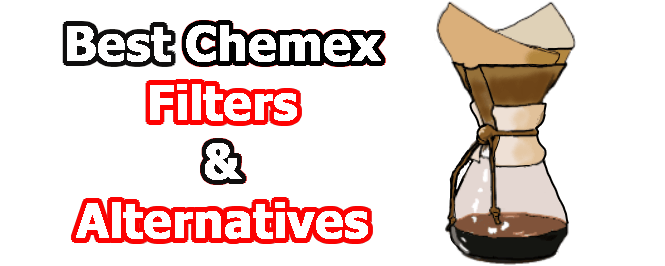
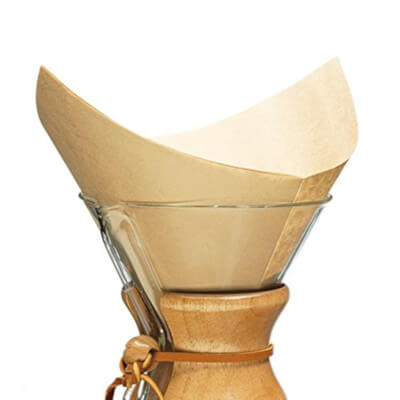
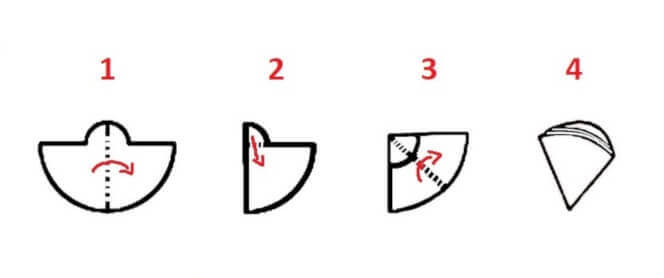

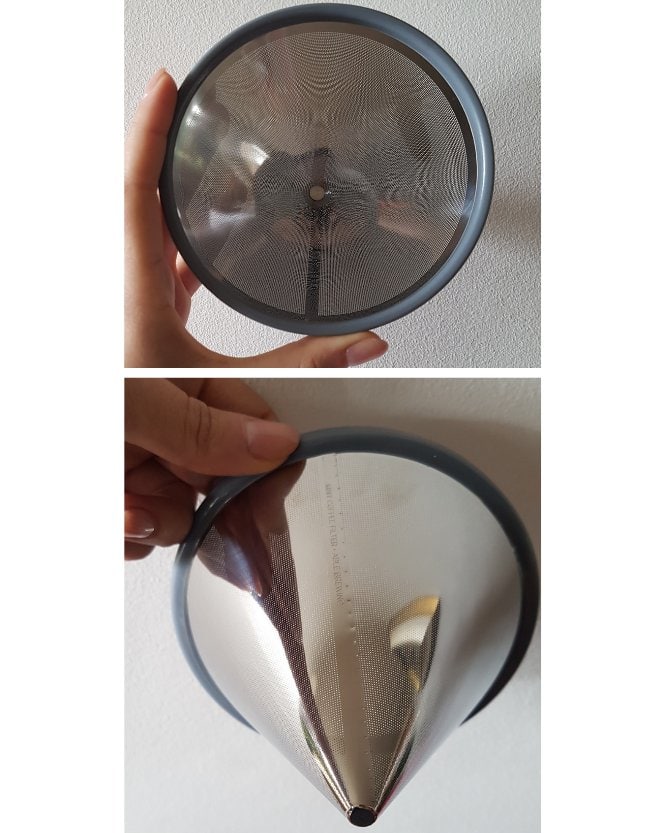
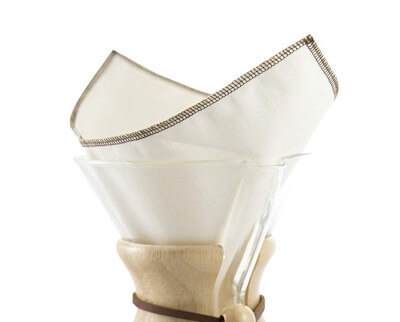
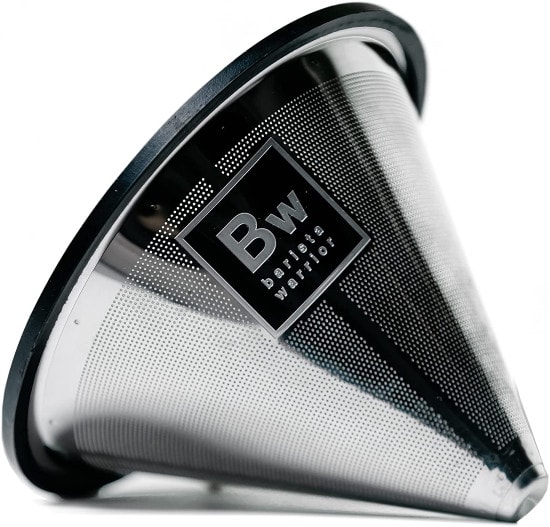


Amazon is almost double the cost for most items. Why would you want to pay over $18 for a box of chemex filters when everyone else sells it for about $10. What a ripoff from Amazon, and the rest of their products are the same high cost. Don’t be lazy—check around!
I’ve read various reports about how well sock filters remove the diterpenes that may raise cholesterol. What is your opinion about this, and would one type of sock filter remove more diterpenes than another?
Thank you for such valuable information!
do any of the Chemex coffee filters contain epichlorohydrin?
This is seriously the ultimate coffee filter guide. This represents years’ worth of experience, knowledge, and expertise–thank you!
I’ve been using the small 3-cup Chemex for about 15 years. I use Chemex filters (they are only the half-circle folding ones for this size) and always very easily unfold, rinse, and reuse 4 or 5 times with no negative impact. I tried cloth filters but they didn’t work well, clogging. And metal ones do not properly filter the harmful oils found in coffee. When you use the new paper filter, put it in place then pour hot water on it to rinse it, and then pour that out and proceed with the coffee. Real Chemex paper filters is the only way—reuse to save money! And of course compost.
Hi, I’ve been trying to use Costco #4 cone filters in my Chemex, and after the second one burst, I’m in search of a solution. Does anyone make something like a glass or ceramic adapter that would fit into the Chemex and support the paper filter? I have pretty much given up trying to make great tasting coffee, but would like a fuller-flavored result than I’ve gotten with the Chemex filters (plus they’re hard to get and quite expensive right now). I’ll probably end up getting the socks if no solution reveals itself. As an example of my lack of sophistication, the best coffee I remember making, which was consistently very good, was a single cup pour over, using a plastic holder, cheap paper filter, water close to boiling (but temp not measured), and coffee beans ground with a rotary grinder. Not really a recipe for success. Part of the greatness may have been due to the locally roasted beans I had access to at the time (but no longer).
Hey, Terry
Unfortunately, there aren’t any ceramic or glass adapters for the Chemex carafe. At least I couldn’t find anything after asking a couple of friends who also own a Chemex and after doing thorough online research.
The only (sort of) solution I can think of is getting one of those (appropriately sized) cone mesh strainers and use it as a base on which you can place the Costco filter. The cone strainer should be able to support it so that it doesn’t burst. But I’ve never tried that myself, so I can’t really tell from experience whether it will work well or not…
Another alternative that’s more affordable than Chemex paper filters and results in a richer cup would be the Hario V60 size 03 filters. Quite a few people I know have used them with the 6-cup carafe without any issues.
If you do like a fuller-bodied cup, you will most likely be happy with one of the stainless steel reusable filter alternatives that I mention in this post. The coffee sock is another great multiple-use option that you can consider if you don’t find something that suits your needs better.
With that being said, I believe that as long as you enjoy your homemade coffee, it doesn’t matter whether you’ve made it by using a precise brewing technique or some sort of fancy gear. Of course, freshly roasted beans always make things better :))
Let me know if you have more questions.
Good luck and take care!
Hi.might not be appropriate place to add this reply, but have you tried adjusting the grind a bit finer?
Yes the Chemex filters are hard to find eifht now. I have been using the natural ones from World Market. Not bad, but need to rinse like 4-5 times
This, too, might not be the right place to comment, but I’ve tried rinsing and reusing Chemex filters. As diligent as I can get, still I’m aware of a paper taste that it didn’t have before when used a second time.